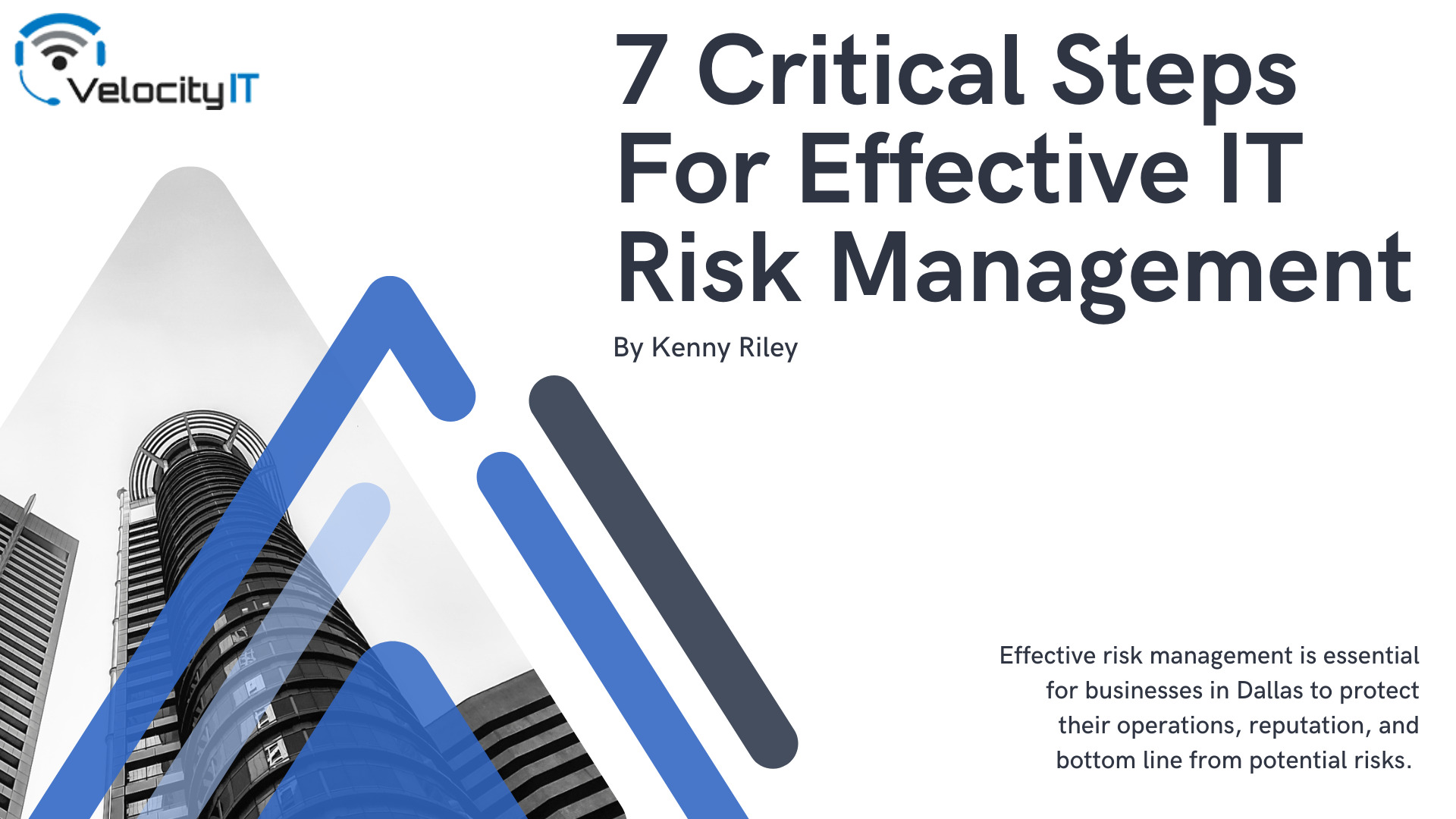7 Crucial Steps for Effective IT Risk Management: A Guide for Dallas Businesses
Business professionals in Dallas face a constant threat of cyber attacks and other IT-related risks that can disrupt operations and damage their reputations.
Finding a reputable and experienced IT company can help them mitigate these risks by providing expert advice, proactive monitoring, and rapid response to potential threats. An IT company can also help businesses in Dallas comply with regulatory requirements and industry standards, which can help them avoid costly penalties and fines. Ultimately, working with a trusted IT company can give Dallas-based business professionals peace of mind and the ability to focus on growing their businesses.
Risk management is critical to running a successful business in the Dallas/Fort Worth metro area.
Outsourcing IT services to a reputable and experienced company can help businesses in the area manage and minimize the risks associated with their IT systems and operations. From cyber security threats to data breaches, an outsourced IT company can provide various services, such as risk assessments, incident response planning, and threat intelligence, to help businesses proactively identify and mitigate potential risks.
Additionally, an outsourced IT company can help businesses in the Dallas/Fort Worth area stay compliant with industry regulations and standards, which can help to prevent costly penalties and fines. Overall, engaging an outsourced IT company can help businesses in the Dallas/Fort Worth metro area to focus on their core operations while ensuring that their IT systems are secure and reliable.
Want to protect your Dallas business from IT risks? Learn the seven essential steps for effective IT risk management and keep your operations, reputation, and bottom line safe!
What Is IT Risk Management?
IT risk management is identifying, assessing, and prioritizing potential risks that could affect an organization's IT systems and operations and then implementing measures to mitigate or manage those risks. This can include risks related to security, data breaches, system failures, regulatory compliance, and more.
IT risk management aims to minimize the potential impact of risks on an organization's operations, reputation, and bottom line. This is achieved by identifying potential risks, analyzing the likelihood and impact of each threat, and implementing controls to mitigate or manage those risks. IT risk management also involves continuous monitoring and reviewing existing controls to ensure they are still effective in managing the risks.
IT risk management is an essential aspect of overall business risk management. IT is a critical infrastructure for most organizations and often involves sensitive personal and financial information. IT risk management can be carried out by internal IT staff or an outsourced IT company with relevant expertise.
Why Having A Risk Management Strategy In Place Is Critical In 2023
Having a risk management strategy in place is extremely important for businesses in Dallas, as it can help them to identify, assess and mitigate potential risks that could affect their operations, reputation, and bottom line. Without a risk management strategy, businesses may not be aware of potential risks or may not have the necessary measures to address them.
IT risks are a significant concern for companies of all sizes in today's business environment. These risks can come from various sources, such as cyber-attacks, data breaches, system failures, regulatory compliance, etc. These risks can cause not only significant financial losses but also damage the reputation of the business.
By implementing a risk management strategy, businesses in Dallas can proactively identify potential risks, analyze the likelihood and impact of each risk, and implement controls to mitigate or manage those risks. This can help to minimize the potential impact of risks on the business and ultimately help the company to continue to operate and grow.
Furthermore, many industries have regulatory requirements for risk management, such as PCI DSS for companies that handle credit card transactions, HIPAA for healthcare providers, and GDPR for companies that handle the personal data of EU citizens. Having a risk management strategy in place can help the business to stay compliant with these regulations and avoid costly penalties and fines.
In summary, having a risk management strategy in place is essential for businesses in Dallas to protect their operations, reputation, and bottom line from potential IT risks.

What Potential IT Risks Exist For Dallas Businesses
There are a variety of potential IT risks that exist for businesses in Dallas, including:
- Cybersecurity threats: Businesses are vulnerable to cyber attacks such as malware, phishing, and ransomware. These can lead to data breaches, system failures, and financial losses.
- Data breaches: Businesses in Dallas store and process sensitive personal and financial information. A data breach can occur due to a cyber attack, employee mistake, or a misconfigured system, leading to the loss of sensitive data, legal liabilities, and reputational damage.
- System failures: Businesses in Dallas rely heavily on IT systems to operate. A failure in any of the systems can lead to interruption in the operations, loss of revenue, and reputational damage.
- Regulatory compliance: Businesses in Dallas are subject to various regulatory requirements, such as HIPAA for healthcare providers, PCI DSS for companies that handle credit card transactions, and GDPR for companies that handle the personal data of EU citizens. Non-compliance with these regulations can lead to costly fines and penalties.
- Natural disasters: Businesses in Dallas are also at risk of natural disasters such as hurricanes, tornadoes, and floods, which can damage physical IT assets and disrupt operations.
- Vendor and third-party risks: Businesses in Dallas may outsource some of their IT services to vendors or third-party providers. A security incident or data breach at the vendor or third-party provider can lead to reputational damage and legal liabilities for the business.
- Human error: Businesses in Dallas can also be at risk due to human error, such as employees falling for phishing scams, mishandling sensitive information, or misconfiguring systems.
Businesses in Dallas need a risk management strategy to identify and mitigate these potential IT risks to protect their operations, reputation, and bottom line.
7 Essential Steps To IT Risk Management
IT risk management is a critical process for businesses to identify, assess and mitigate potential risks that could affect their IT systems and operations. Essential steps for IT risk management include risk identification, assessment, control, monitoring and review, and reporting. These steps are essential for businesses in Dallas to protect their operations, reputation, and bottom line from potential IT risks.
Businesses must have a risk management strategy and integrate it into their overall business risk management strategy. Businesses can proactively identify and mitigate potential risks, minimize their impact, and ensure compliance with regulatory requirements.
- Risk identification: The first step in risk management is identifying potential risks that could affect an organization's operations, reputation, and bottom line. This can include risks related to security, data breaches, system failures, regulatory compliance, and more. Identifying potential risks can be done through risk assessments, threat intelligence, and other methods.
- Risk assessment: Once potential risks have been identified, the next step is to assess the likelihood and impact of each risk. This can involve analyzing the potential consequences of each risk, such as financial losses, reputational damage, or system failures.
- Risk prioritization: After assessing the risks, the next step is to prioritize them based on their likelihood and impact. This will help to determine which risks need to be addressed first and which can be managed through risk retention.
- Risk control: After prioritizing the risks, the next step is implementing controls to mitigate or manage those risks. This can include implementing security measures, such as firewalls and antivirus software, incident response plans, and data backup procedures.
- Risk monitoring: The risk management process is not a one-time event. It is an ongoing process. The risks and controls must be continuously monitored to ensure they are still effective in managing the risks. This can include regular security audits, penetration testing, and vulnerability assessments.
- Risk review and reporting: Finally, the risk management process should include regular review and reporting of the risks and controls. This can include reporting to management and other stakeholders on the effectiveness of the risk management process and any issues or areas for improvement that have been identified.
- Risk communication: It is essential to communicate the risks and the risk management process with all the stakeholders. This includes the employees, management, clients, and partners. This will help them understand the risks and their responsibilities in managing them.
It's important to note that IT risk management is an ongoing process and should be integrated into the overall business risk management strategy. IT risk management is an essential aspect of overall business risk management. IT is a critical infrastructure for most organizations and often involves sensitive personal and financial information.
FAQs
What are the 7 essential steps for effective IT risk management?
The 7 essential steps for effective IT risk management include risk identification, assessment, prioritization, control, monitoring, review and reporting, and communication.
How can I assess the likelihood and impact of potential IT risks for my Dallas business?
You can assess the likelihood and impact of potential IT risks by analyzing the potential consequences of each risk, such as financial losses, reputational damage, or system failures. Additionally, you can hire an IT consulting firm to help you conduct a risk assessment and provide expert advice.
What are the potential IT risks that exist for businesses in Dallas?
Potential IT risks for businesses in Dallas include cybersecurity threats, data breaches, system failures, regulatory compliance, natural disasters, vendor and third-party risks, and human error. It's important for businesses in Dallas to have a risk management strategy in place to identify and mitigate these potential risks.



